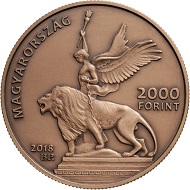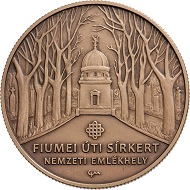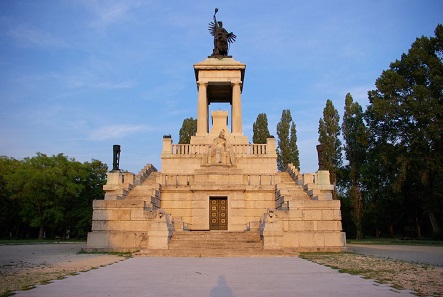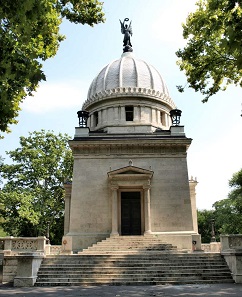August 2, 2018 – In partnership with the National Heritage Institute, the Magyar Nemzeti Bank launched a series of collector coins presenting national memorials in 2014, with a new coin added every year. In 2015, for example, a coin was issued commemorating the battle at Mohács of 1526. The latest addition to this series depicts yet another important heritage site.
Hungary / 2,000 Forint / Cupro-Zinc / 18.4 g / 37 mm / Design: Márta Csikai / Mintage: 5.000.
Honoring the Fiumei Road Cemetery, the Magyar Nemzeti Bank is issuing a 2,000-forint, bronze-patina collector coin as part of the “National Memorial Sites” series. The coin was designed by the sculptress Márta Csikai. The center of the front of the coin features a half-view of one of the cemetery’s most well-recognized set of statues which also serves as inspiration for its logo: the statues atop the Kossuth tomb, with the winged genius of freedom, strength and enlightenment holding a torch in one hand and a lion freed from its chains symbolizing the Hungarian nation, by the sculptor Alajos Stróbl. The back of the coin shows the Deák mausoleum and the walkway leading to it, with gravestones in the background.
The statue atop the famous Lajos Kossuth mausoleum. As Governor-President at the time, he presented the Hungarian Declaration of Independence during the Hungarian Revolution of 1848/49 / Photo: Daniel Wessel / CC BY 3.0.
With a history reaching back almost 170 years, the Fiumei Road Cemetery has become a famous site similar to the Père-Lachaise Cemetery in Paris, but instead of the graves of Molière, Chopin and Jim Morrison one can visit the final resting places of renowned Hungarians such as Ady, Jókai, Arany, Kossuth, Erkel, Faludy, Jancsó and Imre Kertész. The cemetery was opened in the middle of the 19th century as a public burial ground in Pest, and it had become the most important one in Hungary by the end of that century. Amongst others, one can find the mausoleums of Lajos Batthyány, Ferenc Deák and Lajos Kossuth. The cemetery also preserves the memories of periods passed since the Revolution of 1848.
The back of the coin shows the Deák mausoleum. Ferenc Deák became the first Hungarian Minister of Justice in 1848 / Photo: Misibacsi / CC BY-SA 2.5.
The highest number of great figures from Hungarian history and culture are buried here, and many of the grave monuments designed by famous architects and sculptors have great artistic value. The cemetery has separate sections for artists, Jacobins, and heroes of the 1848 and 1956 revolutions, and the grand mausoleums also illustrate the funerary culture of the party-state period. Almost resembling an arboretum, the huge 56-hectare cemetery is also known for its rich flora and fauna. This unique cemetery has been managed by the National Heritage Institute since 2016 and welcomes its guests with dignity.
For more information on this release visit the website of the Magyar Nemzeti Bank.
The latest addition to the Hungarian national memorial coin series can be purchased at the Hungarian Mint online shop.
To go on a virtual tour around the beautiful Fiumei Road Cemetery, watch this film on Youtube.








